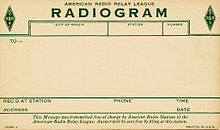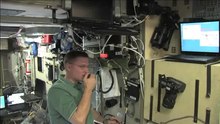History of the amateur radio service
The history of amateur radio describes the development of amateur radio and its further development up to the present day. Right from the start, it was closely interwoven with general radio technology and its history, also in terms of personnel, as many later researchers and developers began as radio amateurs , often at a young age, and amateur radio accompanied them through their entire lives.
The beginnings

As early as 1873, James Clerk Maxwell theoretically predicted the existence of electromagnetic waves on the basis of the work of Michael Faraday . On November 11, 1886, Heinrich Hertz succeeded in an experiment in transmitting electromagnetic waves from a transmitter to a receiver. On December 13, 1888, he taught the Berlin Academy of Sciences in his research report "On rays of electric force" on electromagnetic waves. Édouard Branly developed the coherer around 1890 . In January 1896, Alexander Stepanowitsch Popow published an article about a "device for detecting and registering electrical vibrations" with which he demonstrated on March 24, 1896 the wireless transmission of signals over a distance of 250 meters. Guglielmo Marconi copied the device and had it patented in June 1896. This is how the history of wireless telegraphy begins . Since a spark could always be observed with the early transmitters, the terms radio operator and spark were formed in German.
As early as 1898, people interested in natural science around the world were already looking into this new technology. Since their activities were not necessarily related to their professional activities, one sees in these actors the first forerunners of the amateur radio.
The first commercial stations at that time used frequencies below 1.5 MHz (one would call it medium wave today ); here a single transmitter could cover long distances, but required a transmission power in the range of a few hundred kilowatts. At higher frequencies, even with such high powers, only distances of up to a few hundred kilometers could be bridged; therefore all higher frequencies ( short wave ) were not used until then. On November 28, 1923, the first two-way radio link on short waves between an American and a French amateur radio station (operated by Léon Deloy ) was established at a wavelength of about 110 meters, that is about 2.7 MHz.
It soon turned out that the short waves could do with a fraction of the power that the large commercial stations generated on the long waves. So far, only the propagation of the ground wave has been investigated; it was only later that scientists discovered that short waves are reflected by the ionosphere . Suddenly the possibility was recognized to establish Europe-wide and even worldwide radio connections with transmission powers in the watt range.
Over the years, many commercial stations have settled on the short waves. Because of the more compact, simpler antenna systems and the much lower power requirement, the necessary investments were much lower.
Since every new shortwave station simply looked for a frequency that seemed unoccupied and went on the air, something had to be done to avoid frequency chaos. Interested parties from all over the world therefore met in 1927 for a world radio conference and distributed the short waves (that is, waves from 100 meters to around 10 meters) among the state and commercial radio stations and left several frequency ranges in the vicinity of 160 , 80 to the amateur radio service , 40 , 20 , 15 and 10 meters wavelength. Even before this crucial conference, the radio amateurs had organized themselves internationally and in 1925 united in the International Amateur Radio Union (IARU) in order to be able to represent their interests. The result of this conference was written down in the Washington World Radio Treaty in 1927 . Today it is the executive order for the radio service that, as the successor to the 1927 agreement, regulates radio usage and still contains the amateur radio bands .
The amateur radio service was thus officially recognized and established as a radio service with equal rights.
The first European amateur radio activities took place in Great Britain due to the Wireless Telegraphy Act of 1904. The first license holders were professionals such as Guglielmo Marconi or John Ambrose Fleming . They had to accept severe restrictions in terms of transmission power, range (maximum ten miles), frequencies and operating times.
The amateur radio in Germany
Recognized radio associations in Germany received test transmitter permits from November 1924. Since the club licenses could only be used by a few radio amateurs and individual licenses were generally not granted, there was increased illegal activity in the following period (“black radio operators”, “pirates”). Another reason for this was the lack of licenses for telephony (AM), those previously issued were only valid for telegraphy. From August 1933, the Deutsche Reichspost issued transmission permits for radio enthusiasts, whereby the number of amateur radio stations rose to around 600 by 1939. One of the conditions for receiving a permit was membership in the German Amateur Broadcasting and Reception Service (DASD). From the beginning of the war in 1939 war radio permits were issued, the number of which reached around 100 at the end of the war in 1945. On March 23, 1949, the first 700 amateur broadcasting and receiving permits were issued on the basis of the Amateur Radio Act, and there are now around 72,700 in Germany (as of December 2018).
In the GDR , members of the Society for Sport and Technology (GST) could acquire a radio license .
After reunification, there were transitional regulations for the new federal states, which, for example, allowed higher transmission power on the 30-meter band than was permitted in the old federal states.
Developments after 1945
When amateur radio operations were allowed again after the Second World War, radio amateurs achieved the following technical successes:
- 1946 first amateur radio connection on 10 GHz ( 3-centimeter band ) and on 21 GHz, by American radio amateurs
- 1953 first earth-moon-earth echoes in amateur radio
- 1960 first earth-moon-earth connection (two-sided)
- 1961 first amateur radio satellite in earth orbit ( OSCAR 1 with a telemetry beacon, first active communication satellite was Courier 1B in 1960 and first civil active communication satellite Telstar 1 in 1962)
- 1965 first active amateur radio satellite OSCAR 3 (with linear transponder)
- 1965 first ever satellite connection USA / USSR ( OSCAR 4 )
- 1975 first ever inter-satellite link ( OSCAR 7 )
- 1975 first amateur radio connection on 24 GHz ( 1.2 centimeter band ) by English radio amateurs
- 1983 first amateur radio connection with the space shuttle
- 1984 first amateur radio connection on 47 GHz by Swiss radio amateurs
- 1985 first amateur radio connection on 76 GHz by Swiss radio amateurs
- 1992 first amateur radio connection on 145 GHz, by German radio amateurs
- 1993 first amateur radio connection on 241 GHz ( 1.2 millimeter band ) by German radio amateurs
- 2006 receiving signals from the probe Voyager 1 from 14,700,000,000 km distance at 8415 MHz with the 20-m-levels of the observatory Bochum by AMSAT Germany
- 2009 first earth-Venus-earth echoes in amateur radio
- 2019 first transponder on a geostationary communications satellite ( Es'hail-2 ).
See also
- German Amateur Radio Club (DARC)
- Austrian Association of Experimental Broadcasters (ÖVSV)
- Union of Swiss Shortwave Amateurs (USKA)
literature
- Clinton B. DeSoto: 200 meters & down: The story of amateur radio. American Radio Relay League, Newington CT 1936, 1981, 2001.
- Ernst Fendler (DL1JK), Günther Noack (DL7AY): Amateur radio through the ages . DARC Verlag Baunatal, 1986, ISBN 3-88692-008-9
- Wolfram Felix Körner (DL1CU): History of the amateur radio . Koerner'sche printing and publishing house, Gerlingen, 1962.
- Kurt Schips (DL1DA): Journey through the Afu story. 100 years of amateur radio. In: CQ DL Spezial (2010), pp. 4-11, pp. 45, pp. 52-58 and pp. 63-67.
Web links
- Documentation archive Funk (Vienna) - amateur radio - history and personalities
- Friends of the Amateurfunkmuseum eV (AFM)
Individual evidence
- ^ Albrecht Fölsing: Heinrich Hertz . Hamburg: Hoffmann and Campe, 1997. ISBN 3-455-11212-9 , p. 275.
- ↑ Deutschlandradio: Discoverer of the waves
- ↑ Statistics on amateur radio approvals and other call sign assignments as well as information on the amateur radio examinations carried out for the years 2000–2018. In: Amateur radio: Statistics on the subject of amateur radio. On Bundesnetzagentur.de, accessed on September 26, 2019 ( Amateur radio in Germany - 2018 subscriber numbers. Bundesnetzagentur, Section 225. PDF ; 53 KB).
- ^ First activity on 10,000 and 21,000 Mc. In: QST, July 1946, p. 140.
- ↑ Bernie glass Meyer, Peter R. O'Dell, Roy Neal: Space Shuttle Columbia calling all radio amateurs. In: QST, August 1983, 50-51.





